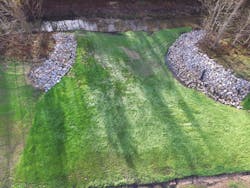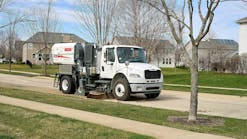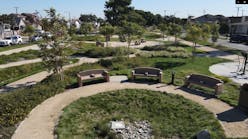About the author:
Matt Welch, CPESC, CESSWI, is technical & business development manager, and Adam Dibble, CPESC-IT, CESSWI, is senior marketing & erosion control brand manager for Profile Products LLC. Welch can be reached at [email protected], and Dibble can be reached at [email protected].
Matt Welch & Adam Dibble
undefinedIn 2016, heavy rains ripped out erosion control blankets and left a creek bed severely eroded at a development site in Texas. The U.S. Army Corps of Engineers (USACE), Texas Commission on Environmental Quality (TCEQ), local Municipal Utility District and developer KB Homes all had ideas on how to remediate the failed site. Many of the proposed solutions, while viable, focused on taming Mother Nature, rather than working with her to prevent future issues.
Instead, the team selected a solution that allowed the site to return to more natural conditions. Stuckey’s Contract Services LP partnered with Profile Products to employ a green alternative to hard armor that offers a means of protecting high-discharge waterways and steep slopes. This solution allowed nature to punch through the creek at the levy break and reinforced the drainage path for inevitable heavy rain events.
Winning Over Mother Nature
Conroe, Texas, a suburb of Houston, is nestled on a floodplain in a wetland forest preserve. From 2015 to 2016, the U.S. Census Bureau named Conroe the fastest-growing city in the U.S., expanding from 76,000 to 82,000 people in only one year—a 7.8% growth, nearly 11 times higher than the national average. This influx of people brought a flurry of construction to the temperamental ecosystem.
Conroe is prone to flooding if rainfall exceeds more than 9 in. in 48 hours. According to a 2008 flood insurance study by Montgomery County, Conroe has a 10% chance of receiving that much rainfall in any given year, but urban development is exacerbating that risk. A study by Texas A&M University found the entire Houston area lost nearly 30% of its wetlands from 1992 to 2010—land that at one time could detain more than 4 billion gal of storm water. When Montgomery County experienced three consecutive 500-year floods from 2015 to 2017, the increase in impervious surfaces made the flooding even worse.
In April 2016, more than 12 in. of rain fell in the Conroe area. In May, another 11 in. fell. It was one of the wettest springs on record for the Houston area. At the time, KB Homes was working on the Cayden Creek subdivision. As the name implies, the subdivision has a small creek running through it; this creek eventually meets up with the San Jacinto River. As development of the subdivision began to increase, so did the amount of water that was being diverted into the creek.
In an attempt to stabilize the site and decrease runoff, contractors worked on vegetating 11 acres of the site with erosion control blankets for more than a year. Despite several attempts, they could not get vegetation to properly establish on more than two-thirds of the site, allowing sediment and runoff to flow into the creek.
When the spring storms hit, the strong water flow and lack of vegetation was too much for the creek to handle. The velocity of the water and the swirling action it created ripped out the blankets, washed away soil and blew out a 30-ft embankment on the creek. The resulting overflow moved into the amenity ponds and the channel. Sedimentation in the channel led to aggradation and decreased capacity, ultimately exposing the channel to a higher risk of flooding.
Leaders on the development site weighed their options.
“All the time, engineers are out here trying to reign in Mother Nature, and we usually never win—Mother Nature is going to win,” said Matthew Skinner, market development manager for Profile Products. “I like this idea of trying to work with nature.”
Realizing that rebuilding the crumbled section of the creek would only lead to a failure in another spot, project leaders chose to reinforce the eroded bank, let the water flow at the break point into the creek, divert the water to a retention pond and then allow it to flow back into the creek downstream.
Using this plan, workers tried to reinforce the new break point with riprap and erosion control blankets. However, the concentrated flow during storm events was too strong. The flowing water easily pushed the large rocks out of the way and deposited them more than 100 yards downstream.
After that initial failure, the project consultants contacted Stuckey's Contractor Services LP, which partnered with Profile Products to create a solution that would establish sustainable vegetation and prevent erosion. The developers asked for results that would be stronger than the previously specified riprap and meet the standards of KB Homes, USACE and TCEQ. Each had its own requirements and guidelines that had to be met.
USACE proposed pouring concrete in the area to bypass the eroded bank and create a pathway for storm water. While concrete could have satisfactorily completed the job, it was not the green solution the team was looking for and would have been expensive to construct. KB Homes was over budget and needed an affordable, aesthetically pleasing solution that would solve its troubles and satisfy its homeowners. In addition, TCEQ examined the project from an environmental standpoint.
The turf reinforcement mat encourages growth.
An Environmentally Friendly Solution
Stuckey’s conducted a soil test to determine why the site was not growing vegetation. The analysis revealed that the soils had a high sand content, with less than 1% organic matter and a pH level higher than 8.5. The poor soil quality likely was the reason vegetation was not establishing in earlier applications.
ProGanics biotic soil media provided the organic matter and biological constituents that helped sustainably establish the vegetation the site needed. ProGanics is a topsoil alternative that accelerates the development of depleted soils and substrates with low organic matter, nutrient levels and biological activity. By working with regional seed and plant experts, the team developed a blend specific to the project site that would thrive in the amended soil.
Stuckey’s then had to address the variety of erosion issues on the site. Starting with the area where the bank collapsed from the high hydraulic shear forces, Stuckey’s selected GreenArmor system 7010. The system works with a Futerra 7010 turf reinforcement mat (TRM) to provide a permanent, lofty and open matrix. This TRM consists of 95% open space and encourages growth. It then is hydraulically infilled with Flexterra high-performance flexible growth medium. Flexterra is designed with thermally refined wood fibers and biodegradable interlocking fibers that firmly anchor seed to soil. When combined with the Futerra TRM, Flexterra provides resistance to shear force while vegetation is establishing. System 7010 is designed to withstand shear stresses of up to 8 lb per sq ft and velocities of up to 14 ft per second. Downstream, where the flow was not as strong, Stuckey’s used Flexterra on the floor of the drainage path.
“These were the most impactful parts of the project,” said Shane Stuckey, director of business development at Stuckey’s Contract Services LP. “Getting ProGanics to establish vegetation on the high sand-content soil, then using GreenArmor to ensure the waters mixing and turning didn’t erode away that high velocity spot. The GreenArmor was constantly building sediment every time it would rain and prevented further erosion loss underneath it.”
Nature’s Approval
Within two months of application, the site already was establishing vegetation for the first time. Over time, silt moved through the system and became trapped in the grass, building a new natural shoreline for the creek that is nearly 6 in. thick. This eliminated the water quality issues the site had experienced downstream.
The real test came in 2017, when Conroe experienced one of the wettest years on record. The Cayden Creek subdivision saw more than 94 in. of rain, including a 60-in. deluge during Hurricane Harvey. After those rains, the developers worried that the vegetation washed away and the banks had collapsed but the site held up. A large amount of silt built up in the ponds, rather than downstream in the creek. Stuckey’s, which holds the maintenance contract on the site, was able to dig out the silt without disturbing the natural creek or impairing water quality.
“The vegetation is thick and uniform and prospering,” Stuckey said. “Everything we did on that project was not what was originally planned. It was a major effort to get everyone involved, but using those methods is now the norm instead of coming in and fixing something that failed. I have engineers specify these products into the job now because of the results we got from this one project.”






